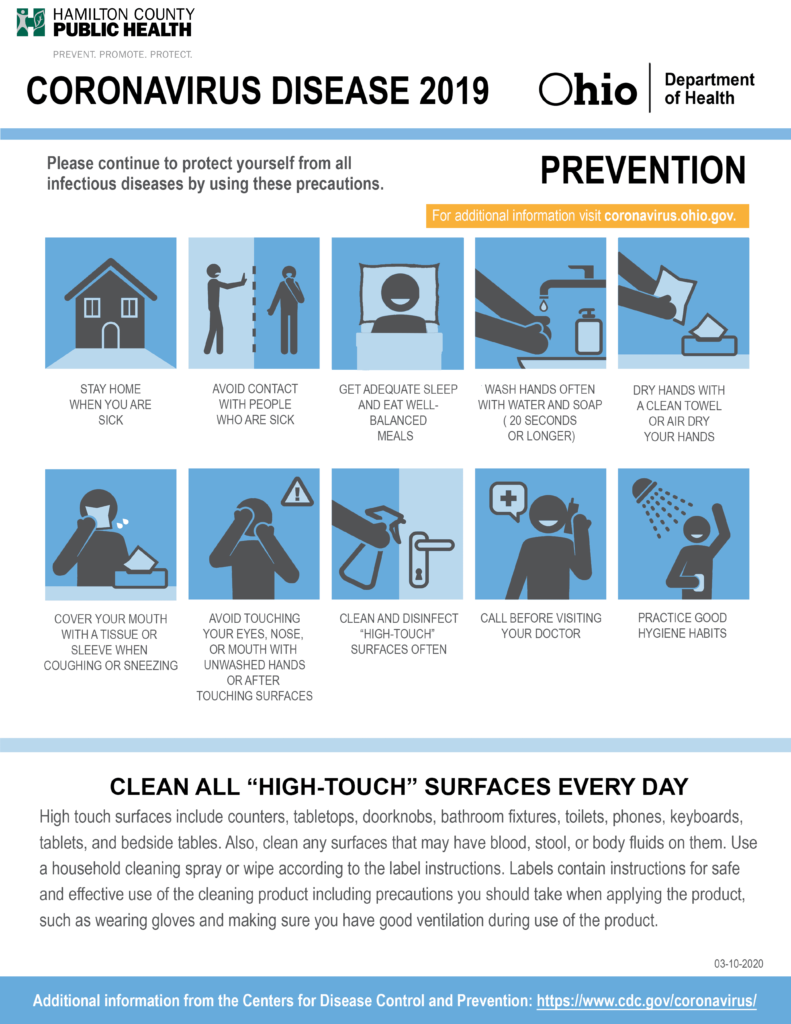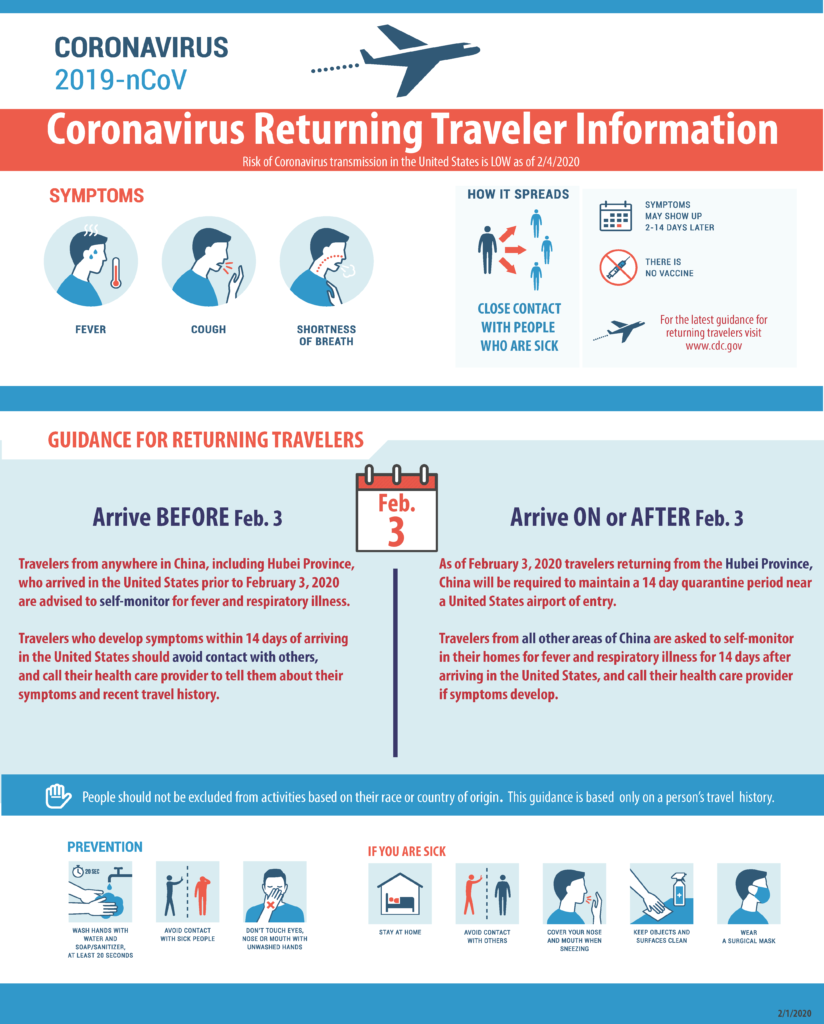Update: March 10, 2020
Click here to read what Hamilton County Public Health is doing to combat Coronavirus (COVID19).
What is novel coronavirus?
2019 Novel Coronavirus (COVID-19) is a virus (more specifically, a coronavirus) identified as the cause of an outbreak of respiratory illness first detected in Wuhan, China. Early on, many of the patients in the outbreak in Wuhan, China reportedly had some link to a large seafood and animal market, suggesting animal-to-person spread. However, a growing number of patients reportedly have not had exposure to animal markets, indicating person-to-person spread is occurring. At this time, it’s unclear how easily or sustainably this virus is spreading between people.
How does novel coronavirus spread?
Much is unknown about how COVID-19, a new coronavirus, spreads. Current knowledge is largely based on what is known about similar coronaviruses. Coronaviruses are a large family of viruses that are common in many different species of animals, including camels, cattle, cats, and bats. Rarely, animal coronaviruses can infect people and then spread between people such as with MERS, SARS, and now with COVID-19.
Most often, spread from person-to-person happens among close contacts (about 6 feet). Person-to-person spread is thought to occur mainly via respiratory droplets produced when an infected person coughs or sneezes, similar to how influenza and other respiratory pathogens spread. These droplets can land in the mouths or noses of people who are nearby or possibly be inhaled into the lungs. It’s currently unclear if a person can get COVID-19 by touching a surface or object that has the virus on it and then touching their own mouth, nose, or possibly their eyes.
Typically, with most respiratory viruses, people are thought to be most contagious when they are most symptomatic (the sickest). With COVID-19, however, there have been reportsexternal icon of spread from an infected patient with no symptoms to a close contact.
It’s important to note that how easily a virus spreads person-to-person can vary. Some viruses are highly contagious (like measles), while other viruses are less so. There is much more to learn about the transmissibility, severity, and other features associated with COVID-19 and investigations are ongoing. This information will further inform the risk assessment. Read the latest 2019 Novel Coronavirus, Wuhan, China situation summary.
What are the symptoms?
For confirmed COVID-19 infections, reported illnesses have ranged from people with little to no symptoms to people being severely ill and dying. Symptoms can include:
- Fever
- Cough
- Shortness of breath
CDC believes at this time that symptoms of COVID-19 may appear in as few as 2 days or as long as 14 after exposure. This is based on what has been seen previously as the incubation period of MERS viruses.
The latest situation summary updates are available on CDC’s web page 2019 Novel Coronavirus.
How can I protect myself?
There is currently no vaccine to prevent COVID-19 infection. The best way to prevent infection is to avoid being exposed to this virus. However, as a reminder, CDC always recommends everyday preventive actions to help prevent the spread of respiratory viruses, including:
- Wash your hands often with soap and water for at least 20 seconds, especially after going to the bathroom; before eating; and after blowing your nose, coughing, or sneezing.
- If soap and water are not readily available, use an alcohol-based hand sanitizer with at least 60% alcohol. Always wash hands with soap and water if hands are visibly dirty.
- Avoid touching your eyes, nose, and mouth with unwashed hands.
- Avoid close contact with people who are sick.
- Stay home when you are sick.
- Cover your cough or sneeze with a tissue, then throw the tissue in the trash.
- Clean and disinfect frequently touched objects and surfaces using a regular household cleaning spray or wipe.
For information about handwashing, see CDC’s Handwashing website
For information specific to healthcare, see CDC’s Hand Hygiene in Healthcare Settings
These are everyday habits that can help prevent the spread of several viruses. CDC does have specific guidance for travelers.

Have there been cases of nCoV in the US?
The Centers for Disease Control and Prevention is tracking the U.S. cases of COVID-19. For the most up-to-date information:
https://www.cdc.gov/coronavirus/2019-ncov/cases-in-us.html
What should we know about travel from China?

For additional travel information, visit the link below:
https://www.cdc.gov/coronavirus/2019-ncov/travelers/index.html
Where can I learn more?
The Ohio Department of Health has a Call Center at 1-833-4-ASK-OHIO.
https://www.cdc.gov/coronavirus/2019-ncov/index.html
https://odh.ohio.gov/wps/portal/gov/odh/know-our-programs/Novel-Coronavirus/2019-nCoV
